Vision: Diverse, connected landscapes valued by the community
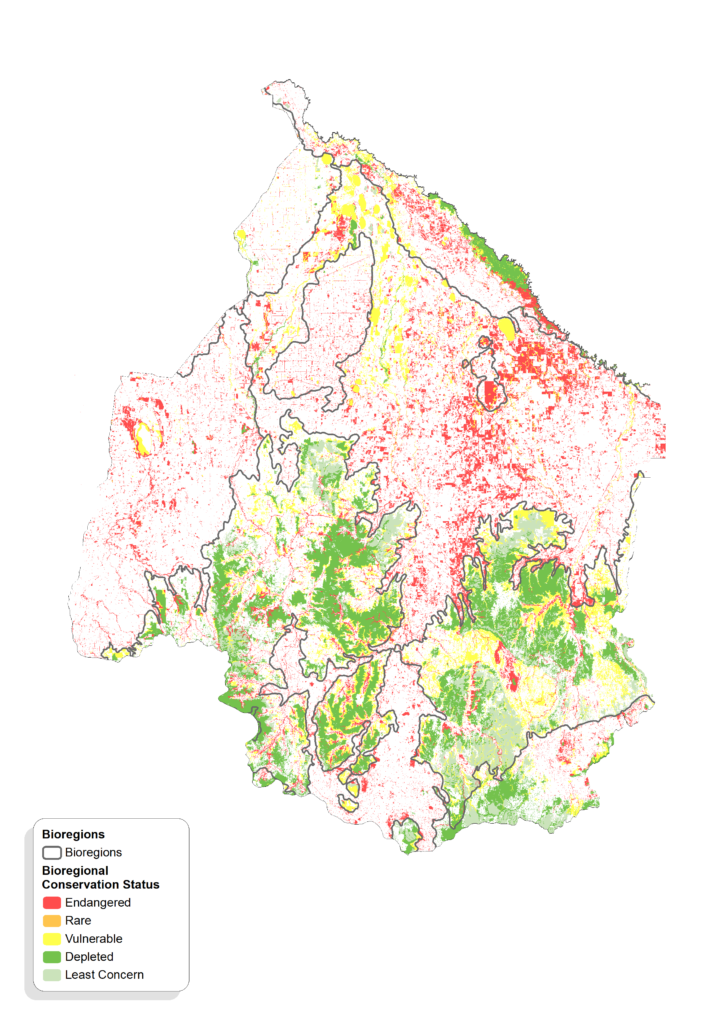
The Biodiversity theme considers native vegetation and habitats including threatened species, with a focus on terrestrial species and environments. Water-dependent species and habitats are addressed under the Water theme.
Biodiversity is the variety of lifeforms, including plants, animals, fungi and micro-organisms. It is the genetic diversity within species, between species and ecosystems.
Biodiversity underpins a healthy natural environment. It is fundamental to our economy, our physical and mental wellbeing. Native plants and animals also have intrinsic value, a right to exist. For the region’s Traditional Owners certain species have cultural or spiritual value, and biodiversity is important for Country to be healthy.
The north central region’s natural environment includes many natural wonders that are treasured by local and visitors alike. From the forests of the Great Dividing Range in the south, through the Box-Ironbark Forests and Woodlands, the Riverine Grasslands, to the River Red Gum Forests along the Murray River corridor in the north. Through engagement for RCS renewal, we heard from community members who are passionate about their local area and are working to protect, enhance and monitor its biodiversity. There are also many nature-based tourism attractions in the region that are important for the regional economy and indirectly support conservation efforts.
However, the region has been extensively cleared for agriculture, particularly on the flatter more fertile plains, where there is less than 30 per cent native vegetation cover. Remnant native vegetation is subject to ongoing loss and degradation, particularly where it is already fragmented. Our changing climate is putting increased pressure on the region’s natural environment. Significant changes in species distribution are predicted with local extinctions likely. Protecting what we have, building ecosystem resilience and connectivity, will be priorities for the next six years and beyond.
Assessment of current condition and trends
The RCS Outcomes Framework mandates a set of Regional Outcomes, (condition and outcome indicators) to be included in all RCSs. For biodiversity, we have described extent of native vegetation and area of permanent protection as indicators of condition on this page, with others addressed in our RCS MERI Framework. Indicators around extent of protected or improved riparian land, and extent of wetlands, whilst relevant to biodiversity, have been included on the Water theme page.
Extent of Native Vegetation
Native vegetation and habitat in the region have undergone a dramatic decline in extent and quality since colonisation. The bioregions with the smallest proportion of native vegetation are the more fertile plains which have been favoured and cleared for agriculture (e.g. Murray Mallee, Wimmera). Conversely the bioregions with a higher proportion of native vegetation, are those with steeper terrain and poorer soils, less favoured for agriculture (e.g. Goldfields).
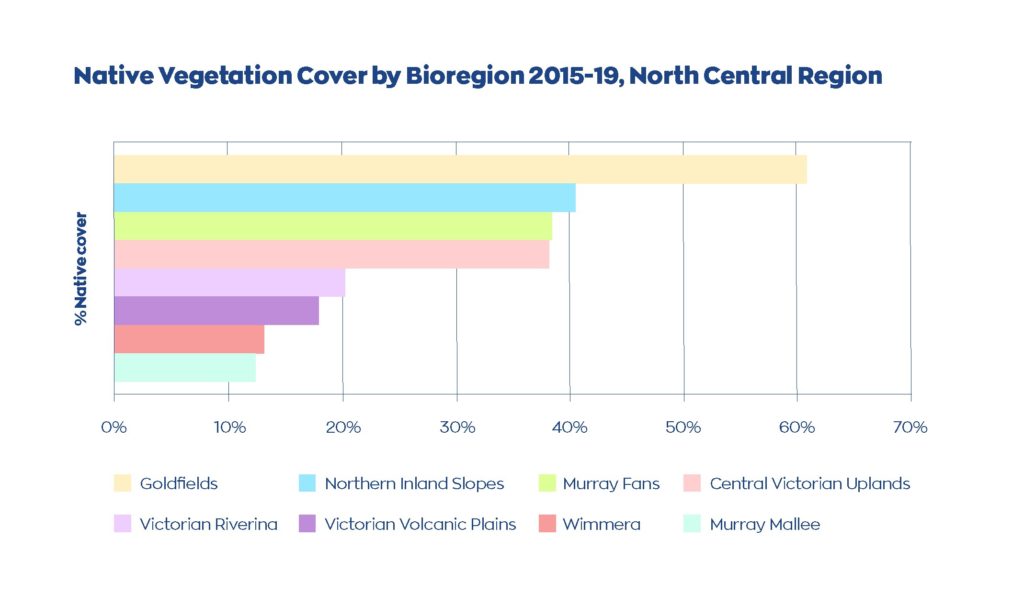
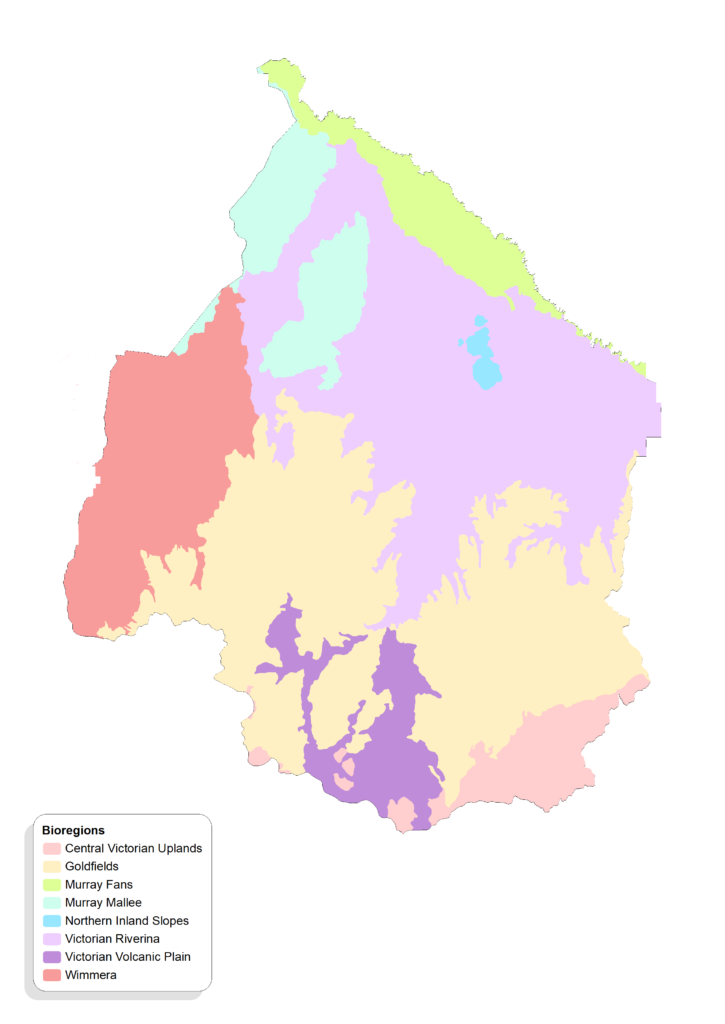
The Victorian Land Cover Time Series 1985-2019 shows trends over time for different land cover classes, including five classes of native vegetation. As shown in the map and graph below, over the past 34 years (between the first epoch 1985-90 and the last 2015-19) there has been a net loss of native vegetation in the north central region. The ‘Native grass herb’ and ‘Native scatted trees’ classes account for most of the losses. ‘Native shrub’ and ‘Natural low cover’ (environments with naturally low to negligible vegetation such as saline lake beds and rocky outcrops) have also declined somewhat – but make up a relatively small proportion overall. ‘Native trees’ is the only class that has increased in area. These native vegetation classes do not account for quality, and it is noted that the relatively large area of ‘Native Grass Herb’ includes grasslands that have been derived through the clearing of trees and/or shrub cover and likely includes large areas of degraded native pastures. This data will be used to track extent of native vegetation over time and progress towards related targets. Refer outcomes below.
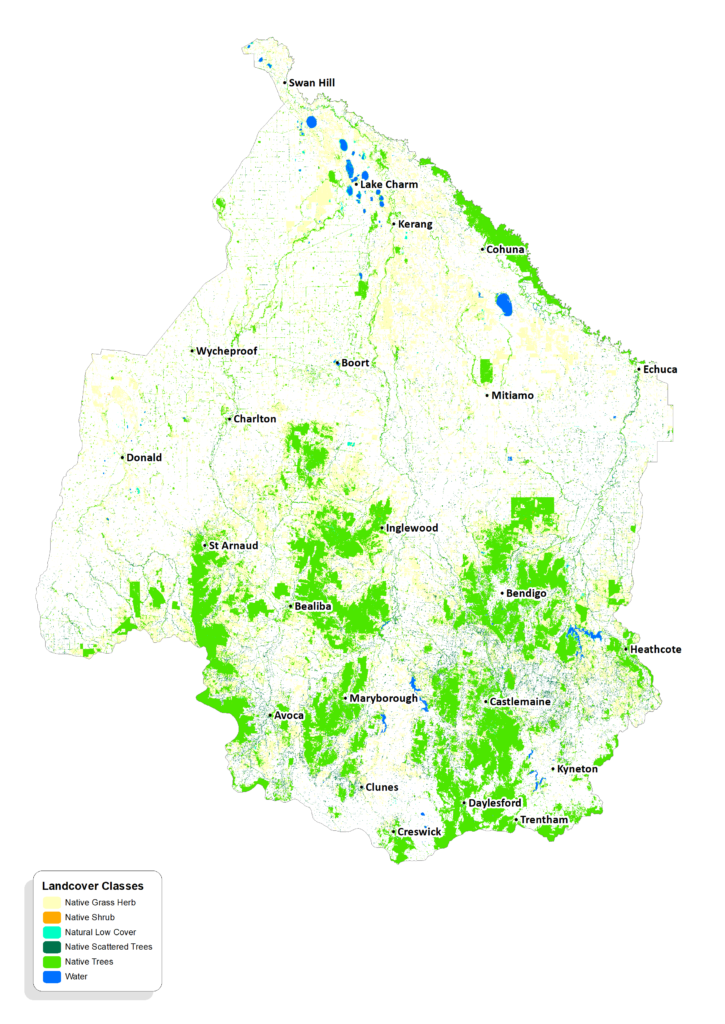
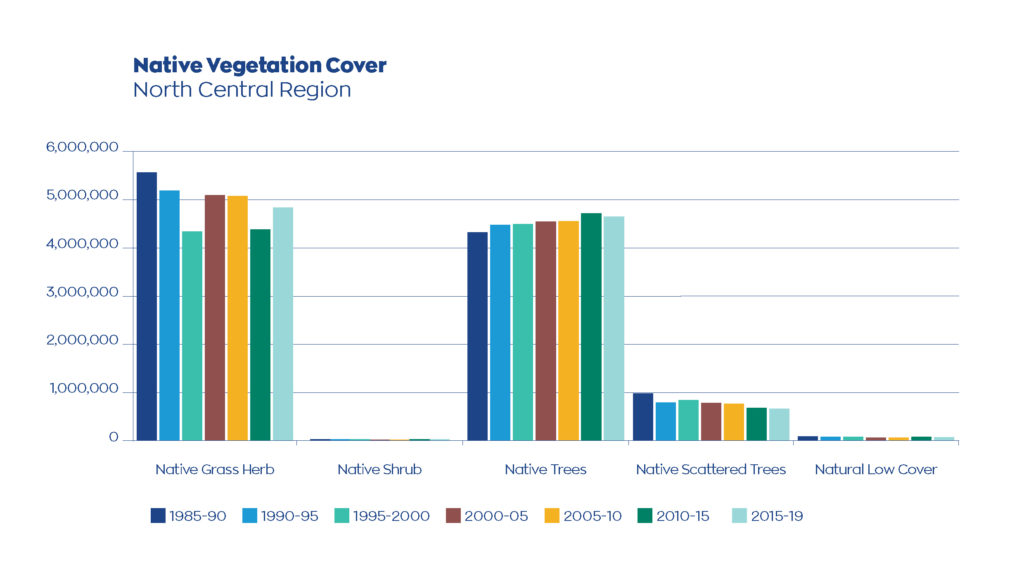
Condition of native vegetation and habitat
Generally, the condition of native vegetation and habitat is assumed to be relatively stable across intact landscapes but declining in fragmented landscapes (except where specific interventions are being made). The bioregional conservation status of remnant native vegetation map above, shows extensive fragmentation across the northern plains. Whilst not visible on this map, fragmentation is also present within bigger remnants. Fragmented remnants are more vulnerable to a range of threats including pest plants and animals.
In the absence of more detailed and accurate information regarding condition, bioregional conservation status provides high level overview of condition as it considers remaining extent, threats, quality of remnants and security of land tenure. Strategic Biodiversity Value (SBV) mapping, which has been used to inform updates to our priority assets updates, also considers condition, combining information on areas important for threatened flora and fauna, vegetation types and condition to provide a view of relative biodiversity value across Victoria. However, there are some important exceptions to these general assumptions and mapping with regards condition, including Box-Ironbark Forests and Woodlands.
Box-Ironbark Forest and Woodlands
Since colonisation Box-Ironbark Forests and Woodlands have been extensively modified through clearing for agriculture, gold mining, urban development, and timber harvesting. Only 17% of the original extent of Box-Ironbark Forests and Woodlands in Victoria remain, most of which are on public land within the north central region, including parks jointly managed by Parks Victoria and Dja Dja Wurrung.
These landscapes support a diverse assemblage of flora and fauna, including many threatened species and communities. However, they are generally in poor condition and active restoration is required to halt further decline and build climate resilience.
Previous clearing and timber harvesting has left forests and woodlands dominated by very high densities of small trees, with little undergrowth, groundcover or topsoil contributing to poor water infiltration and slow rates of litter recycling (refer photo on left). The loss of large trees as an important source of food and habitat, has significant implications. Drainage lines and associated gullies, which are important habitat and refuges in this landscape, have been disproportionately disturbed and badly eroded, and heavy rainfall runs off quickly instead of being absorbed (refer photo on right). Poor water use efficiency makes these landscapes vulnerable to further drying under climate change.
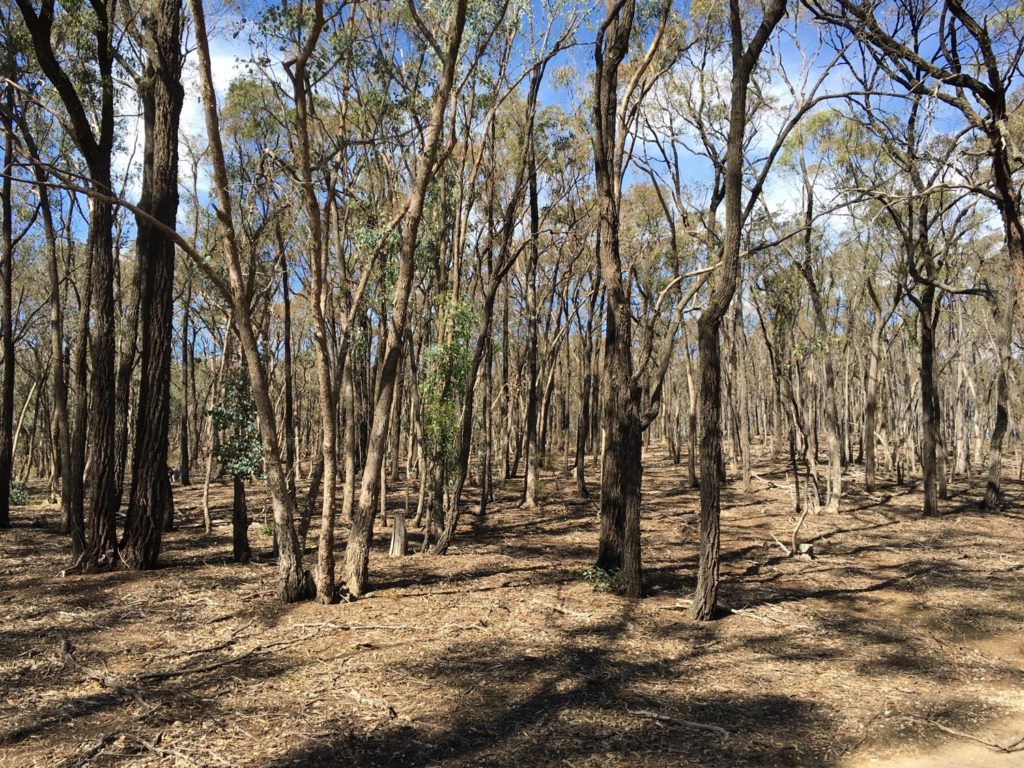
To allow trees to mature and improve the structure and habitat value of these forests, interventions such as ecological thinning is required. Restoration works are needed to improve the retention and infiltration of water and the ecological functions of soil (and associated biota) in this landscape. Other management recommendations from the Environment Conservation Council’s Box-Ironbark Forests and Woodlands, Investigation (2001) are still relevant today. At the time of writing, a pilot project is being developed, to trial a holistic approach to restoration – the Spring Plains Watershed Repair in the Spring Plains Nature Conservation Reserve, Heathcote. An RCS priority direction has been developed to support more pilot projects across the region and to inform and broaden this practice in Box-Ironbark Forests and Woodlands.
Parks Victoria manages 183,063 hectares (6% of the region, 48% of all public land) in the north central region, including the five National Parks (Terrick Terrick, Gunbower, Kara Kara, Heathcote Graytown and Greater Bendigo). Their ‘State of the Parks‘ program gathers, analyses and summarises the best-available information on the condition, issues and the management effectiveness for Parks Victoria managed land and is another resource for understanding the condition of biodiversity within Parks Victoria’s estate in the region.
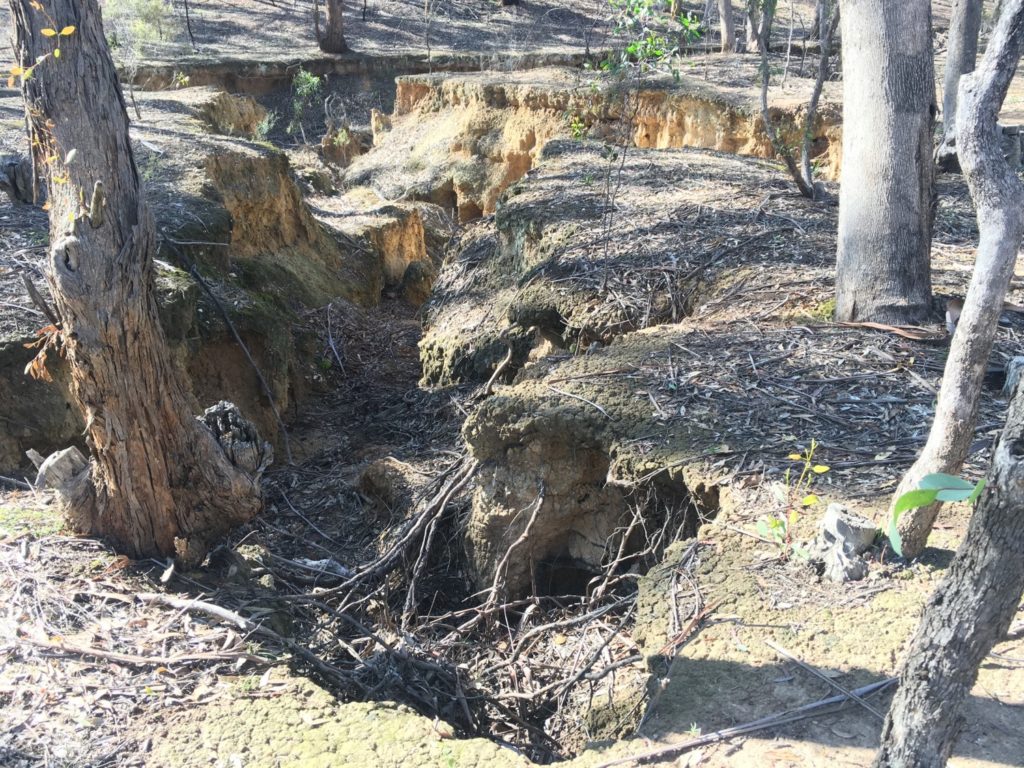
Threatened species and communities
The north central region is home to many threatened flora and fauna species and communities. Just prior the release of this RCS, the Conservation Status Assessment project, was concluded, which established a consistent approach to assessing and listing threatened species and resulted in a single list, called the Flora and Fauna Guarantee Act 1988 (FFG Act) Threatened List for Victoria. The status of many of Victoria’s threatened species were updated through this process.
Threatened species can require substantial expertise and survey effort to monitor population trends. For this reason, our knowledge of many threatened species is deficient. Regardless, we know that threatened species are vulnerable to any change that might push them to the edge of their tolerance, including climate change. In the region’s Box-Ironbark Forests and Woodlands for example, many species, particularly woodland birds, continue to decline even though widespread clearing of these landscapes has stopped. It is recognised that a time-lag on species response to past clearing occurs, but fragmentation and ongoing threats are also contributing. Unless these declines are reversed, it is expected that more common species will become threatened, and many threatened species will become extinct.
Many threatened ecological communities listed under the EPBC Act and FFG Act are known to occur within the region. A map of potential distribution of EPBC-listed ecological communities across Victoria can be viewed here, though accurate mapping is limited, as field assessments are required to determine if relevant condition thresholds are met. A few examples that are known to occur in the region include, the White Box-Yellow Box and Blakely’s Red-Gum ecological community (EPBC Act) the Northern Plains Grassland community and the Victorian Temperate Woodland Bird Community (FFG Act).
Area of permanent protection
Australia’s National Reserve System is made up of Commonwealth, state and territory reserves, Indigenous lands, protected areas managed by non-profit conservation organisations, and areas protected on private land. Given the majority (87%) of the north central region is privately owned, permanent protection of significant biodiversity values on private land, through mechanisms such as covenants, is an important component of the region’s conservation projects, including the current Plains Wanderer project (refer below). Trust for Nature is a not-for-profit conservation organisation working to permanently protect and restore biodiversity on private land, using legally binding covenants. Using the National Reserve System’s guidelines for establishing a ‘Comprehensive, Adequate and Representative’ (CAR) reserve system, Trust for Nature estimates there is a total of 678,913 ha of under-represented vegetation on private land in the north central region. Within these areas, and in accordance with their conservation objectives, Trust for Nature is targeting areas that increase viability at a landscape-scale and increase resilience in the context of climate change. Refer Trust for Nature’s Statewide Conservation Plan for private land in Victoria.
The ‘area permanently protected’ is one of the RCS Outcomes Framework state-wide condition and outcome indicators. This will be tracked over time using the Collaborative Australian Protected Areas Database (CAPAD). Areas currently protected are shown in the table and map below. DELWP has provided the north central regions’ contribution to Protecting Victoria’s Environment – Biodiversity 2037 targets, including for increasing the area permanently protected. See Outcomes below.

Areas of permanent protection in the north central region. Source: Collaborative Australian Protected Areas Database Terrestrial (CAPAD) and Trust for Nature for covenants.
| Protection Type | Number of protected areas | Proportion of total protected area (%) | Total area (ha) | Additional area (ha) since 2017 |
| Conservation covenant and other private lands | 259 | 8% | 13,045 | 1,702 |
| National Park | 5 | 30% | 47,039 | 241 |
| State Park | 588 | 51% | 79,171 | -179 |
| Other* | 4 | 10% | 15,516 | 0 |
*Other: includes any other protected area types listed in the region, e.g. Heritage River, Natural Features Reserve, Wilderness Zones, etc.
Major threats and drivers of change
Loss and degradation of native vegetation, habitat and fauna
Native vegetation and habitat loss, subsequent fragmentation and degradation continue to be significant threats to biodiversity across the north central region. Historically, the agriculture and mining sectors were primarily responsible for broad-scale clearing. These days the main drivers are residential development and agricultural intensification, including the conversion of pastures, to crops or ‘improved pasture’, which though less obvious in terms of structural changes to the vegetation, are equally destructive. Habitat loss and degradation reduces the resource base (i.e., food, shelter and mates) for individual animal species resulting in smaller populations with lower genetic diversity, increasing the probability of local extinction. It reduces overall species richness and diversity and leads to a decline in landscape amenity and intrinsic values.
| Native vegetation and habitat loss (clearing, lopping and destruction) through: -regional population growth and associated residential, industrial, infrastructure development -land use changes (e.g. grazing to cropping) and increased mechanisation (bigger machines and removal of paddock trees) -timber and firewood harvesting -wildfire and clearing to reduce wildfire risk in increasingly populated areas -conversion of irrigation channels to pipelines. |
| Native vegetation and habitat degraded and further fragmented through: -weed invasion -illegal off-road activity on public land -over-grazing by stock and pest animals (e.g. rabbits, pigs) and native herbivores (e.g. kangaroos) -inappropriate fire regimes -altered hydrology, introduction of in-stream barriers (e.g. weirs), removal of in-stream habitat (e.g. woody debris) -introduction of sediments, increased nutrients and contaminants through run-off (from roads, urban areas, agricultural land, and industry). |
| Native fauna loss through: -pest animal predation (e.g. foxes and feral cats), poaching and vehicle accidents -diseases introduced/spread by human activity. |
Given the extensive loss in native vegetation extent and quality since colonisation it is important to protect, maintain and restore what is left – much of which is already fragmented, in poor condition and subject to ongoing threats. Building climate resilience, including climate-wise connectivity between remnants will also be important, as discussed further under the climate change and connectivity headers below.
Remnant native vegetation along roadsides include threatened communities and are important corridors for wildlife particularly in otherwise cleared agricultural landscapes. In the early 2000s significant vegetation along roadsides was mapped across the region and some signage installed. Through engagement for RCS renewal many community members and partners expressed frustration that illegal removal of native vegetation, including of listed threatened communities, continues to occur through slashing/clearing/cultivating of roadsides and on private land, with no consequence. This is particular concern for threatened grasslands, which are not as easy to identify. Some barriers include lack of community awareness or appreciation and a lack of resources for Local Government enforcement. Increasing the awareness of legal requirements to retain native vegetation and advocating to improve compliance has been identified as a priority direction in this RCS.
Given most of the region is privately owned, initiatives that encourage and support landholders to protect remnant native vegetation and habitat on their land, and to revegetate continue to be important. Landholders and their communities working together through community-based NRM groups such as Landcare make a significant contribution to protecting and enhancing the regions biodiversity. Refer to the discussion under the Community theme for more on community-based NRM groups. Refer to the discussion regarding leveraging the carbon market under the Opportunities header below. Refer to the Land theme page for more regarding stewardship programs.
Pest Plants and Animals
Pest plants and animals, including predators and herbivores, are major threats to our region’s biodiversity and are the focus of significant effort by public land managers, private landholders and community-based natural resource management groups like Landcare. Weeds outcompete native species, changing and destroying habitat and in some cases increasing wildfire risk (e.g. gorse in southern areas of the region). Predators including cats and foxes, are the number one cause of native animal extinctions. Herbivores, like rabbits, deer and goats, also contribute to loss of native vegetation and habitat and soil degradation. Pest plant and animals also impact agricultural productivity. Both public and private landholders have a responsibility under the Catchment and Land Protection Act 1994 (CaLP Act) to control pest plants and animals. Some Landcare networks engaged for this RCS, expressed their frustration that members were overwhelmed and fatigued by weed management activities. Supporting volunteers is vital to enable them to continue their important role in controlling pest plant and animals to protect our region’s biodiversity as discussed further under the Community theme. Targets for weed and pest animal control are included under Outcomes below.
Threatened species
Protecting Victoria’s Environment – Biodiversity 2037 shifts the conservation management approach from planning for individual threatened species to broader-scale threat management that benefits multiple species, thus reducing the risk of species becoming more threatened. However, it also acknowledges that some endangered and critically endangered species will not benefit from this approach. Using DELWP’s new Threatened Species Framework we will be able to identify critically endangered and endangered species, with core habitat in the region that are not expected to benefit from the landscape-scale actions currently in Strategic Management Prospects (SMP). For these species a targeted approach is warranted. The Threatened Species Framework and other Naturekit products such as Species Reports and Specific Needs Assessments can inform the development of effective targeted threatened species programs. Single species management actions will need to be balanced against landscape-scale approaches, to maximise the benefit to the most species and to enhance resilience across the landscape.
The Australian Government invests in regional threatened species management through the Regional Land Partnerships (RLP) program, guided by their Threatened Species Strategy which has been renewed for 2021-31 to include a new place-based objective. This extends the focus to threat mitigation and habitat protection across landscapes, which is more aligned with the Victorian approach. For more on current RLP investment in threatened species in the north central region refer the Delivery page.
The Plains-wanderer is a Critically Endangered species, listed under the Federal EPBC Act. Ninety-one per cent of its Habitat Distribution Model is within the north central region and it is in the bottom 10th percentile of species benefiting from landscape scale actions currently in SMP. So it is a prime candidate for a targeted program, as described below.
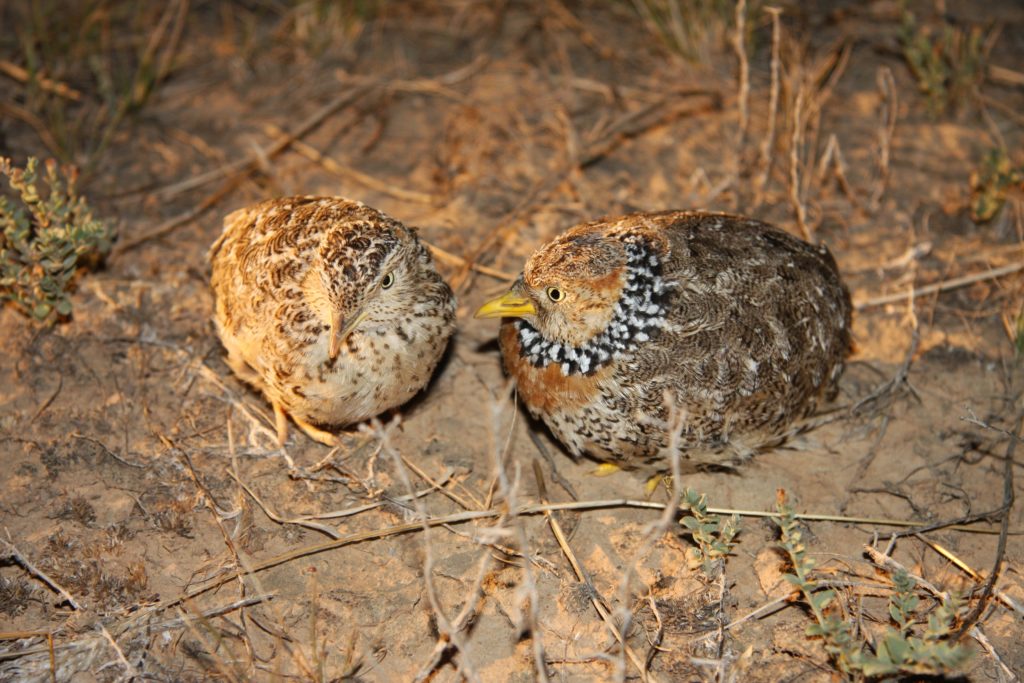
The Plains-wanderer has already lost 95% of its native grassland habitat through development and cultivation, with an estimated 250 – 1,000 individuals left in the wild. Both the Plains-wanderer and its native grassland habitat in the region (Natural Grasslands of Murray Valley Plains) are listed under the Federal EPBC Act. Habitat within the north central region includes the Patho Plains, Lower Avoca Grasslands and Bunguluke priority biodiversity assets. While the species can coexist with a sustainable grazing regime there is ongoing loss of habitat due to land use change from grazing to cropping in the region, which is a serious concern for the species. The Northern Plains Conservation Management Network is a group of farmers working with government and non-government organisations to raise awareness to permanently protect and enhance habitat and monitor populations. Parks Victoria manage two of the critical habitats for Plains-wanderer at Terrick Terrick National Park and Bael Bael Nature Conservation Reserve, and the ecological management of grassy biomass across these parks requires intensive and responsive management to meet specific habitat requirements. Zoos Victoria supports these efforts through a captive breeding program.
Fire
Aboriginal people used fire as a tool to manage landscapes for thousands of years prior to colonisation. Ecosystems evolved to tolerate and depend on fire. With colonisation, the fire regime changed. Today fuel reduction burns are carried out to reduce the risk of bushfires which threaten communities and can burn too hot to achieve ecological benefits. With a warmer and drier climate predicted under climate change, bushfire risk is set to increase. Through our engagement for RCS renewal, inappropriate fire regimes and removal of woody debris (habitat) to reduce fire risk, were identified as threats to biodiversity. There is a strong aspiration amongst Traditional Owners to reinstate cultural burns and a growing recognition of their value. DELWP and Parks Victoria are committed to resource and actively support the integration of Traditional Owner-led cultural burns in the region. Refer priority directions below.
Climate change
Climate change poses a serious threat to biodiversity, exacerbating existing threats. Native vegetation is likely to be directly impacted through changes to annual and seasonal rainfall patterns and increased temperatures, with flow-on effects including increased fire frequency and severity, and more favourable conditions for some weeds. Any change to the local ecological niche of species can place them near the limits of their physiological tolerance. There is already evidence of climate change causing large shifts in the composition of communities and changes in the centres of species distribution. Overall, changes in species composition are expected to occur more quickly in ecosystems already under stress, and more gradually elsewhere.
However, it is inherently difficult to predict the more specific impacts of climate change on our region’s biodiversity, given the complexity of interactions within and between ecosystems against background variability. Long-term monitoring is required to detect changes, particularly gradual changes like the observed decline in the woodland birds of our region. However, interventions are urgently required to halt and reverse declines such as this. Long lead times and increased effort are required over and above what we’re doing now. Even then, it may be too late to prevent local extinctions.
The North Central Climate Change Adaptation and Mitigation Plan 2015, considers the vulnerability of native vegetation in the region under climate change. This analysis highlighted a number of priority areas (e.g. Wedderburn – Wychitella) are especially vulnerable to climate change. However, vulnerabilities also exist where remnants are fragmented. Low-cost and low-regret adaptation strategies that minimise current risks to biodiversity and improve climate resilience should be prioritised including:
- Maintaining, enhancing, buffering good quality remnant native vegetation and habitat including areas more resistant to climate change (mostly in the southern parts of the region), riparian corridors and high-quality drought refuges.
- Continuing to improve the resilience of native vegetation and habitat generally, through management of current/emerging threats.
- Using species of different provenances (future climate analogs) for revegetation as is happening in the Bush Heritage Climate-Ready Revegetation Research Project at Nardoo Hills.
Other more specific adaptation actions to protect biodiversity such as large-scale connectivity projects or conservation of threatened species, warrant consideration of climate scenarios, risks, vulnerabilities, costs, benefits etc., to inform decision making. New and innovative approaches may be needed.
A priority direction has been developed to identify biodiversity adaptation priorities for the region, including refuges to protect, areas to build climate resilience and a strategic approach to climate-wise connectivity.
Connectivity
Given the fragmentation of remnant native vegetation and habitat in the region, connecting areas of native vegetation, to enable species movement, so they can access suitable and sufficient habitat to meet their needs, is a priority for the region. We must now consider this in the context of climate change. ‘Climate-wise connectivity’ is about connecting current habitat with habitat that will become suitable in the future in order to create a network of migration pathways. North-south connectivity, to allow species to move to cooler areas in the south of the region will be important. Continuing to enhance the riparian corridors of major river systems in the region will contribute to this, as they are natural movement corridors, climate gradients, and refugia.
The North Central Climate Change Adaptation and Mitigation Plan 2015 provides some guidance on broad north-south and east-west connectivity priorities for the region. The Biolinks Alliance identify broad landscapes for connectivity across the region, support local planning and capacity building. Landcare Networks, Trust for Nature and Bush Heritage amongst others, are actively involved in planning connectivity projects, including the Kara Kara Wedderburn Landscape Plan, which encompasses six RCS biodiversity priority assets.
While large-scale connectivity projects can be costly and difficult to deliver because they can require the support of several private landholders and public land managers, the carbon market may help to facilitate this, as described further under ‘Opportunities’ below. It is encouraging to note that functional connectivity can, and has been achieved by local communities working together, to enhance existing corridors (riparian and roadside) and include stepping stones, such as scattered trees, in the landscape, as has been achieved with the Cobaw Biolink (otherwise known as Campaspe-Maribyrnong Headwaters Biolink) in the south of our region.
A priority direction has been set to develop a strategic approach to climate-wise connectivity in the region in order to prioritise future works. Connectivity is also important for aquatic species and this is addressed under the Water theme.
Opportunities
The carbon market will support bio-sequestration projects. This presents opportunities for extensive investment in the region, to deliver on a range of co-benefits including for biodiversity e.g. retention and protection of on-farm biodiversity, biodiverse farm forestry and large-scale revegetation (including for connectivity) projects across both public and private land. Government and industry mandated emissions targets, stewardship and industry accreditation schemes will also help drive this. In order to maximise the biodiversity benefits from these projects, e.g. encourage biodiverse, connected plantings rather than isolated monocultures, collaboration between government partners, private landholders and investors is required.
The North Central Climate Change Adaptation and Mitigation Plan 2015 includes a regional map of carbon potential, which suggests that the southern parts of the region, with higher average rainfall, have the greatest potential. Further research is underway to better understand the carbon sequestration potential across Victoria, considering different methods, costs and benefits, to help water corporations achieve net zero carbon emissions by 2040. This work will inform further investment in our region to maximise benefits.
Priority assets
The North Central RCS takes an asset-based approach, identifying the region’s highest priority natural assets (waterways, wetlands and biodiversity) to focus our efforts and investment on protecting and enhancing those assets with the most significant values, that are under the greatest threat, and with the highest likelihood and feasibility of protection and enhancement.
The RCS priority biodiversity assets were initially identified for the 2013-19 RCS. This process involved engaging the community and partner organisations, the use of ecological databases, modelling, decision support tools and advice from ecologists. Finally, these were amalgamated to form large catchment-scale assets. For more details refer Strategy Development.
In renewing the RCS for 2021-27, we reviewed the priority biodiversity assets considering new knowledge and policy. The North Central CMA worked with DELWP to engage with partner organisations, community and Traditional Owners and identify priorities for both the RCS and regional Biodiversity Response Planning. Some biodiversity priorities were also identified through the interactive map on the North Central RCS renewal, Engage Victoria webpage.
Updates were made to the RCS priority biodiversity assets, by comparing the areas identified through engagement, with Strategic Biodiversity Values (SBV) and Strategic Management Prospects (SMP). Where these aligned, and there was a concentration of values, either adjacent to an existing asset or large enough to constitute a new asset, they have been included as updates, as shown on the map here. Through the RCS renewal engagement process some places which the community identified as important have not been included as priority assets. This should not diminish the value of these places. Engaged and active communities who care for their local environment are an asset in themselves, and different funding streams (e.g. Landcare grants, carbon market) can be leveraged for locally important assets.
The key outcome of the DELWP-led regional Biodiversity Response Planning process was a set of Focus Landscapes and associated fact sheets. Within the north central region these landscapes are broadly based on and generally align with the RCS priority biodiversity assets, though there are some differences due to the different approaches used. DELWP intends to update the Focus Landscapes over time, whereas the RCS priority biodiversity assets will remain in place for the next six years.
The decision support tools and products available via the Naturekit portal, notably SMP, will help biodiversity managers identify and prioritise the most effective and efficient management options for the greatest number of species, within the priority areas identified.
‘Climate-wise connectivity’ has been identified as a priority for this RCS. This may involve improving connectivity within and between these priority biodiversity assets.
Traditional Owners have a holistic view and understand Country to be interconnected. The separation of RCS themes and prioritisation of specific assets in this RCS runs contrary to this view. When presented with a draft map of priority biodiversity assets, one Traditional Owner suggested that we start by connecting them all up. Exploring how cultural landscapes might inform future planning is an emerging priority for some Traditional Owners. Cultural landscapes are a traditional way of understanding and managing Country, ‘the planning unit of choice.’
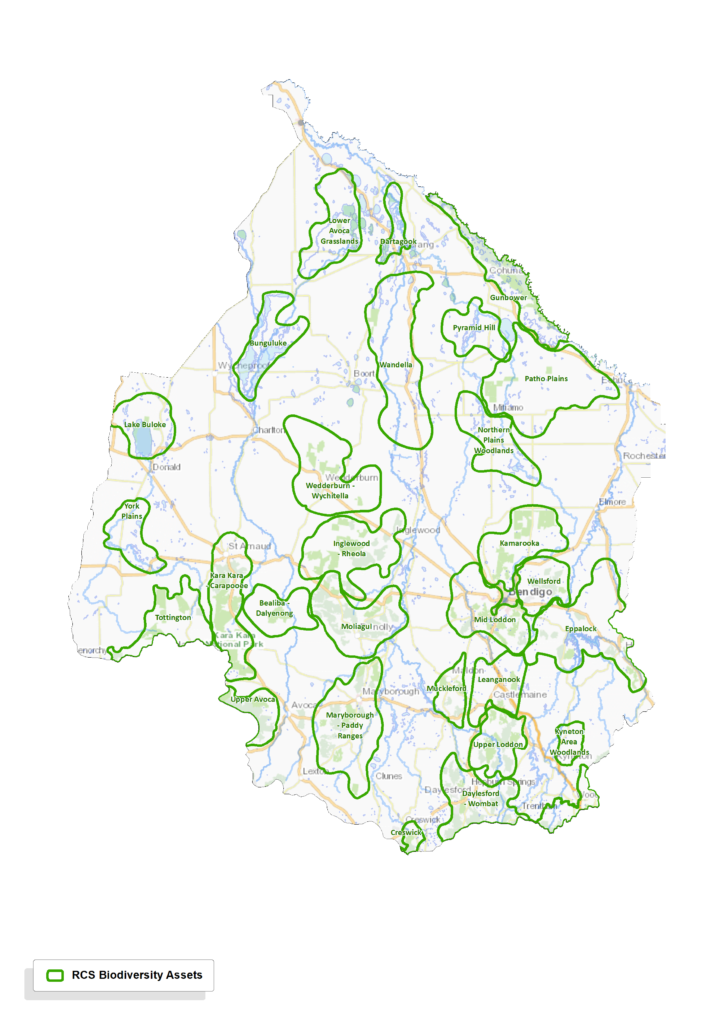
,
Priority directions
The priorities in Protecting Victoria’s Environment – Biodiversity 2037, together with challenges and opportunities identified through engagement for RCS renewal, have informed development of the following priority directions for biodiversity.
We engaged key government partners to confirm delivery roles and improve accountability for RCS implementation. The organisations identified as ‘key collaborators’ in the tables below, will be involved in initiating (including to source investment), but in order to succeed, partnerships, participation and support of many others is needed, including;
- Rural landholders, associated community-based NRM groups, volunteers and the broader community, who make a significant contribution to biodiversity management on both private and public land.
- Government, non-government, industry and research organisations.
Traditional Owners
The key approaches proposed to deliver RCS outcomes (including biodiversity) on private land as described further on the Land theme page include:
- Participatory community-based approaches that build capacity empowering land managers/owners to make informed decisions.
- Supporting and recognising stewardship, and holistic land management for agricultural productivity and ecological values.
Self-determined participation and leadership by Traditional Owners, including in biodiversity planning and management, is identified as a priority direction for this RCS, consistent with Victorian government policy. (Refer Traditional Owners and Aboriginal Victorians Policy Context for more details). Some specific Traditional Owner identified priorities for biodiversity include, bringing back species of cultural importance and integration of traditional management practices such as cultural burns, as reflected in the priority directions below.
Species of cultural importance identified by Dja Dja Wurrung to bring back include:
- Murrup (spirit) that is connected with stories and identity, including Gal Gal (Dingo), Barramul (Emu) and Yung (Quoll).
- Food and fibre plants that were once abundant on Djandak (Country), and have cultural significance, such as Buwatj (grasses used for grain), Witji (weaving grasses) and Gatjawil Matom (tuberous plants with scented flowers).
- Wamba Wemba, Barapa Barapa and Yorta Yorta Traditional Owners identified totem species of importance. (Refer to the Traditional Owner page and associated pages for each Nation to find more detail on Traditional Owner values and priorities).
Plans for implementation
There is currently no biodiversity strategy or plan for the north central region. The key outcome of DELWP’s regional Biodiversity Response Planning process in 2020, was a set of Focus Landscapes and associated fact sheets. The fact sheets for each Focus Landscape include:
- Outcomes of engagement including values, threats and species of interest identified by Traditional Owners, partners and community.
- Outputs from SMP identifying species with >5% of their Victorian range in each landscape and maps showing the top 10% of cost-effective actions.
The following plans outline approaches to biodiversity management for specific areas of the region:
Parks Victoria’s state-wide Land Management Strategy (under development) will set the direction for Parks Victoria’s land management including nature conservation, cultural heritage management and visitor management and services. Parks Victoria is also developing Conservation Action Plans (CAP) for each of their landscapes across Victoria. So far there is a CAP for the River Red Gum Park Landscape and others are being developed for the Central Goldfields and Northern Plains and Riverina landscapes, which are all relevant to the north central region.
The Dja Dja Wurrung Recognition and Settlement Agreement involved transfer of six parks in the region to Aboriginal Title. In collaboration with partner organisations the Dhelkunya Dja Land Management Board developed a Joint Management Plan (JMP) for these parks which include:
- Greater Bendigo National Park
- Hepburn Regional Park
- Kara Kara National Park
- Kooyoora State Park
- Paddys Ranges State Park
- Wehla Nature Conservation Reserve.
Bush Heritage Australia and Trust for Nature jointly developed the Kara Kara-Wedderburn Landscape Plan 2016–20 (soon to be renewed) to enable the local community to work together to reverse the decline of threatened species and to reconnect natural ecosystems of the Kara Kara-Wedderburn region. This area encompasses six priority biodiversity assets.
| Priority Directions | Key collaborators |
| Continue to build partnerships with Traditional Owners towards self-determined participation in biodiversity planning and management. | DELWP, Parks Vic and Traditional Owners in partnership. |
| Identify regional priorities for biodiversity adaptation to climate change, including refuges to protect, areas to build climate resilience and a strategic approach to climate-wise connectivity. | DELWP, Biolinks Alliance, Parks Vic, Trust for Nature, Bush Heritage, CMA |
| Maintain and improve the quality of our remnant native vegetation and habitats, considering climate resilience, with a focus on RCS priority biodiversity assets. | DELWP, CMA, Parks Vic, Trust for Nature |
| Build climate-wise connectivity by: promoting a broad strategic approach, enabling and encouraging local investment and action, leveraging incentives and market opportunities. | CMA, DELWP, Landcare networks, Parks Vic, Biolinks Alliance. Trust for Nature |
| Continue to support targeted programs for threatened species that do not benefit from broad scale approaches, using DELWP’s Threatened Species Framework to identify priority species and develop cost-effective management options, to halt their decline. | DELWP, Parks Vic, Trust for Nature, Bush Heritage, CMA |
| Undertake pilot projects across the region, to develop effective methods for holistic Box-Ironbark Forest and Woodland restoration, to inform and broaden this practice and increase investment in their management. | Parks Victoria, Biolinks Alliance, Dja Dja Wurrung and Taungurung, CMA |
| Establish a regional biodiversity forum for RCS partners to collaborate on enhancing the region’s biodiversity. | CMA, DELWP |
| Improve the retention and restoration of native vegetation and habitat on private land through; community education and community-based programs that support stewardship and permanent protection, leveraging government and market-based incentives. | CMA, DELWP, Ag Vic, Local Govt., Trust for Nature, Connecting Country |
| Support strategic, long-term programs to monitor the effects of climate change on the region’s biodiversity. | DELWP, CMA, Parks Vic |
| Collaborate to maximise the potential of carbon market investment, to contribute to land, water and biodiversity outcomes. | DELWP, CMA, Parks Vic, Ag Vic |
| Collaborate to increase awareness of legal requirements for cultural heritage management, and the protection of threatened species and communities, and improve compliance. | DELWP, Local Govt, CMA, Parks Vic |
| Support and enable opportunities for Traditional Owners to return species of importance to the landscape. | DELWP, public land managers and relevant non-government organisations to support Traditional Owners. |
| Support the integration of Traditional Owner-led cultural burns. | DELWP and Parks Vic to resource and actively support Traditional Owners. |
Outcomes
Aside from the ‘extent of native vegetation’ outcome, the following outcomes were provided by DELWP as the north central regions contribution to Protecting Victoria’s Environment – Biodiversity 2037 targets.
It is expected that the state-wide target of Protecting Victoria’s Environment – Biodiversity 2037, for net improvement in the outlook of all species by 2037, as measured by Change in Suitable Habitat, will be achieved by using decision support tools like SMP to inform cost-effective management approaches that benefit most species, and by reaching our regional contribution to Protecting Victoria’s Environment – Biodiversity 2037 targets as provided by DELWP and outlined below. Allocation of hectares for each outcome is based on priority locations to maximise cost-effectiveness for biodiversity benefit, as determined by the SMP tool. Noting that some endangered or critically endangered species do not benefit from landscape approaches, and targeted programs are required.
Implementation of these outcomes in the north central region, will be guided by the following key biodiversity priority directions (from table above)
- Identify regional priorities for biodiversity adaptation to climate change, including refuges to protect, areas to build climate resilience and a strategic approach to climate-wise connectivity.
- Maintain and improve the quality of our remnant native vegetation and habitats, considering climate resilience, with a focus on RCS priority biodiversity assets.
- Build climate-wise connectivity by promoting a broad strategic approach, enabling and encouraging local investment and action, leveraging incentives and market opportunities.
| Long-term Outcomes | Key collaborators |
| Increase overall extent of native vegetation from 2017 levels, by 2037. | DELWP, Parks Vic, Trust for Nature, Bush Heritage, CMA |
| 13,000 ha increase in the area permanently protected, between 2017 and 2037. | Trust for Nature |
| 22,000 ha of revegetation in priority locations for habitat connectivity, between 2017 and 2037. | DELWP, Parks Vic, CMA |
| 70,000 ha of priority assets under sustained weed control (not year by year cumulative total) by 2037. | DELWP, Parks Vic, CMA |
| 130,000 ha of priority assets under sustained herbivore control (not year by year cumulative total) by 2037. | DELWP, Parks Vic, CMA |
| 40,000 ha of priority assets under sustained pest predator control (not year by year cumulative total) by 2037. | DELWP, Parks Vic, CMA |
| Medium-term outcomes | Key collaborators |
| Increase native vegetation extent to 2017 levels, by 2027. | DELWP, Parks Vic, Trust for Nature, Bush Heritage, CMA |
| 6,500 ha increase in the total area permanently protected, between 2017 and 2027. | Trust for Nature |
| 11,000 ha of revegetation in priority locations for habitat connectivity, between 2017 and 2027. | DELWP, Parks Vic, CMA |
| 56,000 ha of priority assets under sustained weed control (not year by year cumulative total) by 2027. | DELWP, Parks Vic, CMA |
| 104,000 ha of priority assets under sustained herbivore control (not year by year cumulative total) by 2027. | DELWP, Parks Vic, CMA |
| 32,000 ha of priority assets under sustained pest predator control (not year by year cumulative total) by 2027. | DELWP, Parks Vic, CMA |
The RCS Biodiversity Discussion Paper was drafted to frame conversations with stakeholders, obtain feedback and inform the development of this webpage. It includes more detail and references.


